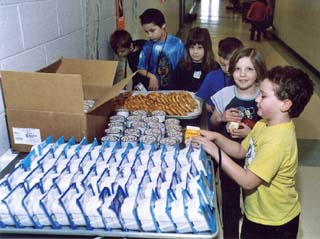
More than 700 Holley Elementary School students enjoy breakfast in the school as part of a grant the district received last year. The program, Elementary Principal Brenda Freida said, is a worthwhile one because "the brain learns best when it is full." While everyone knows the importance of sending a child off to school with a full stomach, the reality is that sometimes children are rushing to get to the bus and miss breakfast, while others may be eating breakfast at 5:30 or 6 a.m. before heading off to a childcare provider's house. Freida said that a lot of the children don't eat lunch in school until noon and that is a long time for them to be without fuel. Holley's breakfast program was funded through the Academic Breakfast Connection and it began in September 2003. "In Holley we have some very affluent families and we have disadvantaged families who struggle to put food on the table," Freida said. "We were serving breakfast to about 100 children as part of the free and reduced lunch program but we knew that there were still some students out there that weren't benefiting from the breakfast program." Now with the breakfast program in place, Freida said the elementary school is feeding about 500 children breakfast each day. While she acknowledges that the program comes with a few challenges, namely taking time away from academics, attempting to find breakfast foods that are "grab and go," and quality and a few minor messes in the classroom, the end result is worth it. "Teachers used to take a 15 minute break in the middle of the morning to allow the students time to have a snack and take a bit of a break. Now the breakfast program takes the place of that mid-morning snack time." Freida said concerns such as children having more than one breakfast per day - those that might have eaten home and were also eating in the district - were addressed by making phone calls to the parents. "We had to be careful of kids eating twice because we don't want to be promoting childhood obesity so we simply contacted the parents and asked whether they wanted their children to be a breakfast program participant," she said. While the program is free to the students and the parents, it is ultimately paid for by the taxpayers but Freida said that if having an empty stomach will impact a child's learning, this program addresses that concern and that higher academic achievement may result. "Overall the program's been a success - there have been advantages and disadvantages but I think its impact on a child's ability to learn can't be denied." |

